Health And Fitness Statistics & Facts 2024
The State of the Health and Fitness Industry in the U.S. and the World: An In-Depth Look at 2023 Trends, Facts, and Statistics.
Summary
Gyms and health clubs are spaces designed to promote physical fitness and well-being. Most modern gyms offer a variety of fitness equipment, personal training services, group classes, and other amenities like swimming pools, spas, or sports courts. In modern times, gyms have become an important part of people’s lifestyles and health, and the industry has seen significant growth and diversification.
In this report, we’ll explore current and future trends in the health and fitness industry, providing a comprehensive analysis of both the global landscape and the United States. We will examine several factors, including the number of health clubs, membership rates, market size, sports activities, and more. Let’s begin.
Methodology
The data and figures in this report were gathered from Statista, a leading provider of market and consumer data. Please note that the data was accurate as of the time of compilation, and certain numbers might have slightly changed with time.
Global Trends In The Health & Fitness Industry
Total Number Of Health Clubs By Region
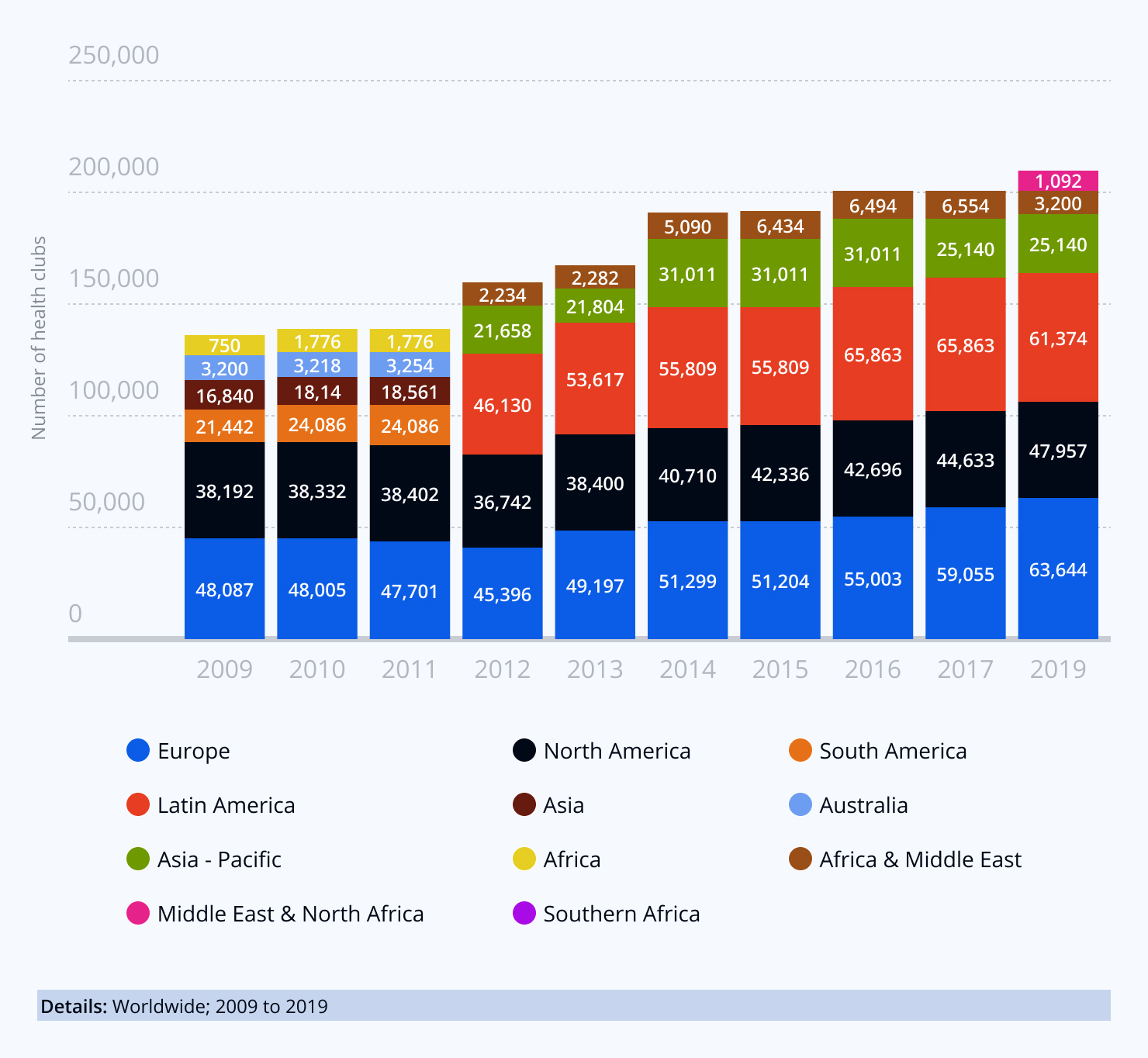
When looking at the global health and fitness industry as a whole, one of the main things to consider is the geographical distribution of health clubs[1]. From 2009 to 2019, the number of health clubs showed considerable growth across all world regions.
- In 2009, the number of health clubs in Europe increased from 48,087 to 63,644 in 2019, an increase of over 30%.
- In North America, health clubs increased from 38,192 in 2009 to 47,957 in 2019.
- In Latin America, the number of health clubs more than doubled from 21,442 in 2009 to 61,374 in 2019.
- In the Asia-Pacific region, the number of health clubs in 2009 increased from 16,840 to 25,140 in 2019.
- In Southern Africa, the number of health clubs went up from 750 to 1,092 in 2019.
Number Of Members At Health & Fitness Clubs
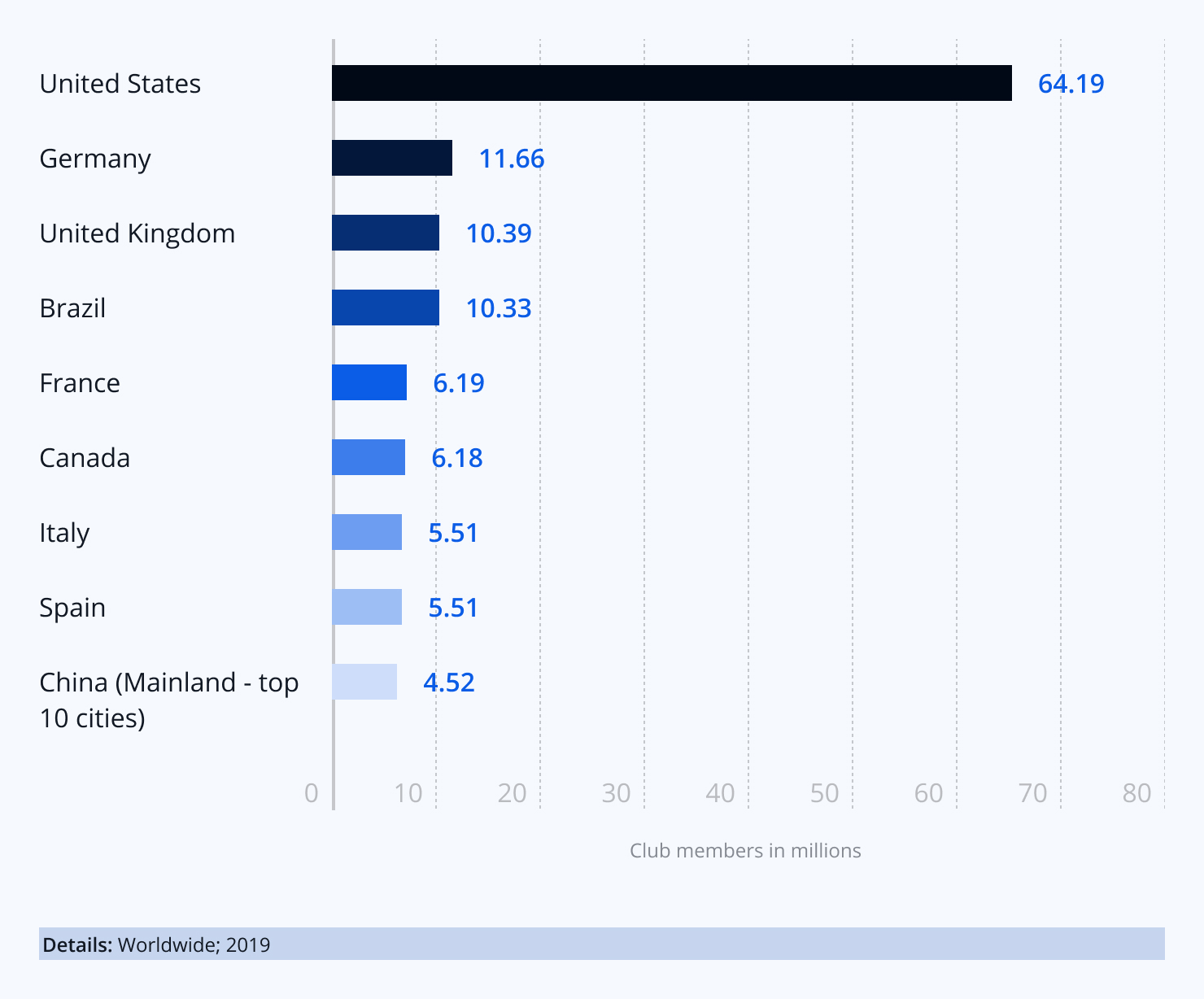
- Health and fitness clubs in the United States reached approximately 64.19 million members[2] in 2019.
- Germany and the U.K. also feature high membership numbers at 11.66 million and 10.39 million, respectively.
- Italy and Spain’s health clubs have an average of around 5.51 million members, respectively
- In Canada, there were approximately 6.18 million health club members in 2019.
These figures help show today’s cultural shift towards prioritizing health and fitness, with more people willing to invest in gym and health club memberships to improve their health and physique.
The Number Of Health & Fitness Clubs
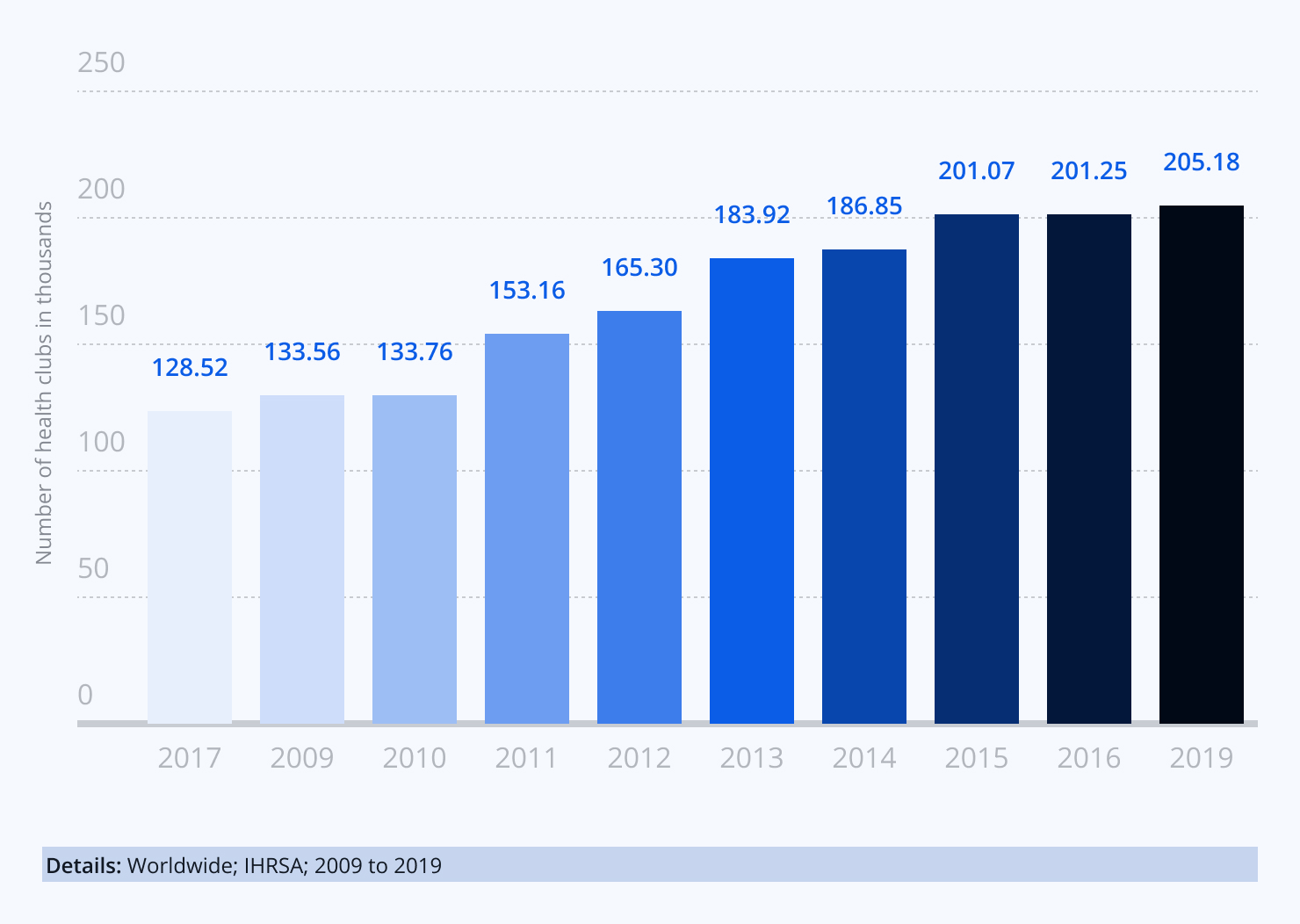
In the context of the entire global landscape[3], the number of health and fitness clubs increased from 128,520 in 2009 to 205,180 in 2019. This figure represents an approximate 60% increase over the decade, showing the impressive growth of the health and fitness industry worldwide.
Size Of Health & Fitness Club Market
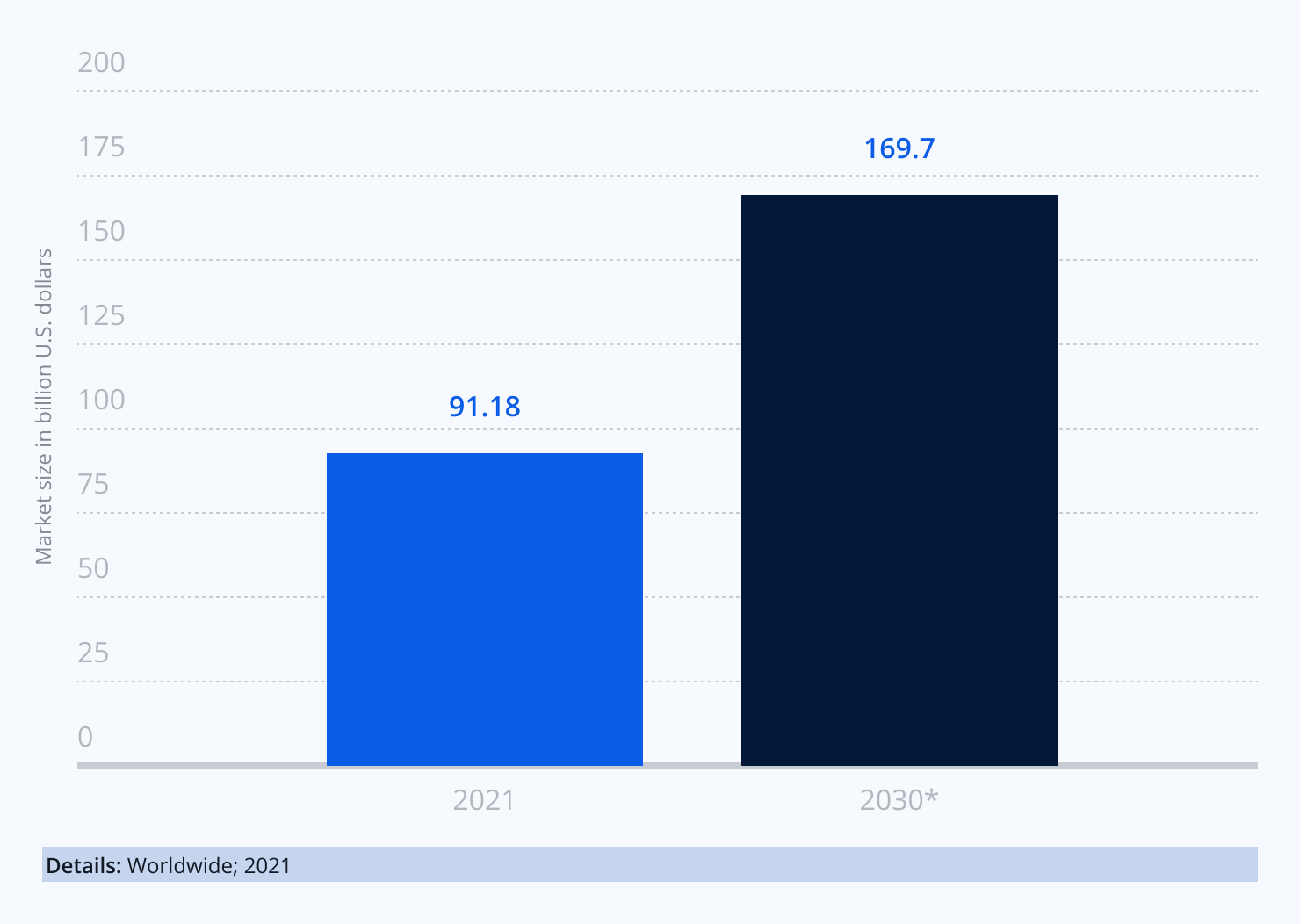
Surveys show that the health and fitness club industry has undergone significant growth in recent years, with a projected to grow[4] at an annual rate of 7.67% for the next nine years.
The industry is expected to be valued at approximately $169.7 billion by 2030, highlighting the potential opportunities available within the health and fitness club market. The rise in consumer interest and advancements in fitness technology and personalization maybe two of the driving factors behind this projected growth.
Monthly Average Cost Of Gym Membership
- In 2021, consumers in the United States reported an average monthly gym membership cost[5] of $28.58.
- Austria and the United Arab Emirates had significantly higher average monthly membership costs, at over $107 and $105, respectively.
- Canada had the cheapest gym membership, costing an average of around $15.91.
How gyms and health clubs decide their pricing strategies varies from region to region and may depend on factors like competition, local wages, and the variety of services provided.
Trends In The Health & Fitness Industry In The U.S.
Now that we’ve explored the global state of the health and fitness industry, let’s take a look at the health and fitness industry in the United States. These trends offer unique insights into how social, economic, and individual factors shape the industry in this region.
U.S. Most Popular Sports Activities In 2023
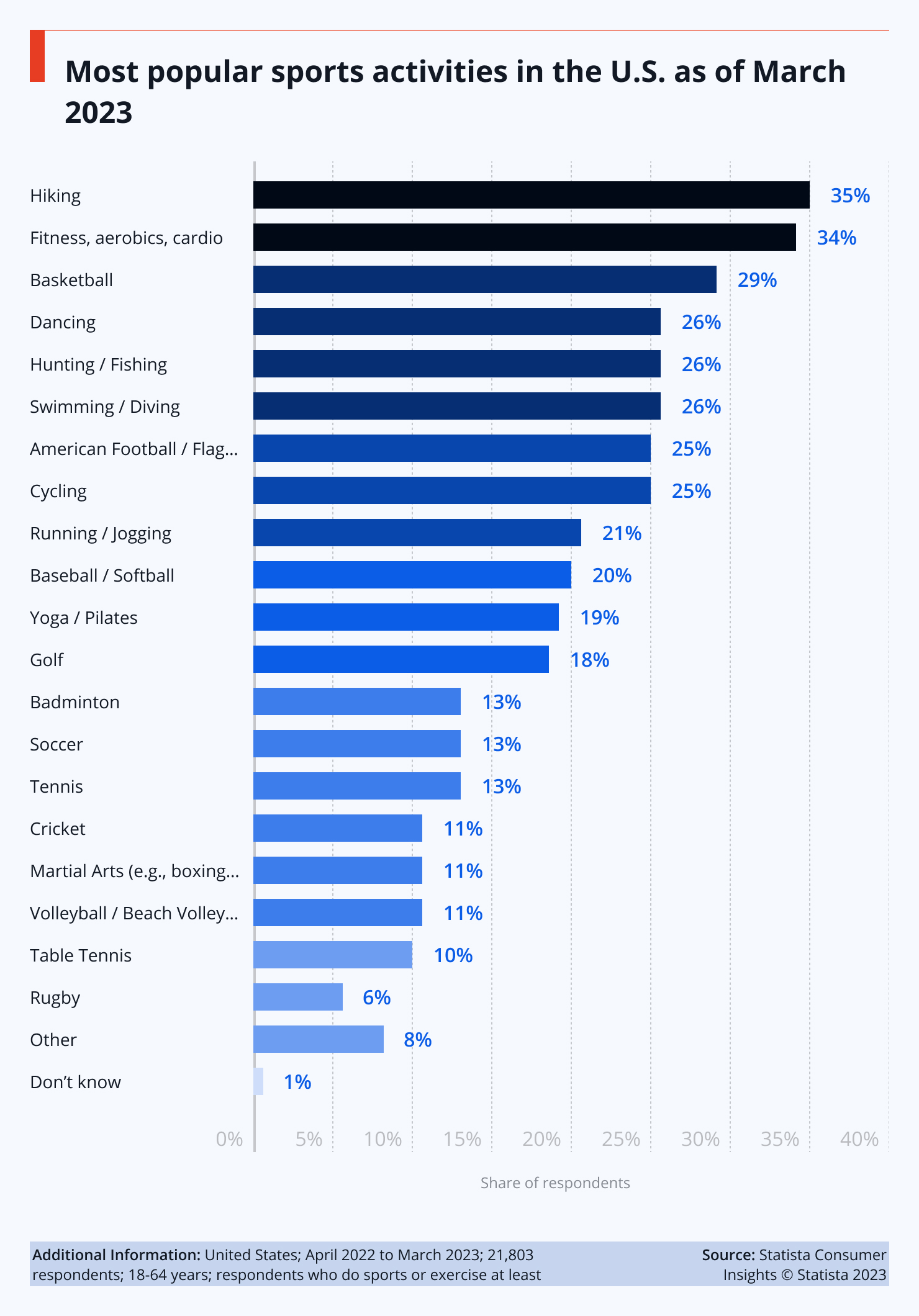
- Hiking was the most popular sports activity among Americans[6] in 2023, with 35% of respondents saying that this was their preferred activity.
- Fitness and cardio activities were chosen by 34% of survey respondents.
- Basketball was favored by 29% of respondents.
- Other popular activities included dancing, hunting and fishing, swimming, and cycling.
- Rugby was the least popular activity among survey takers, with only 6% of them choosing it as their preferred activity.
Daily Time U.S. People Spent On Sports, Exercise & Recreation
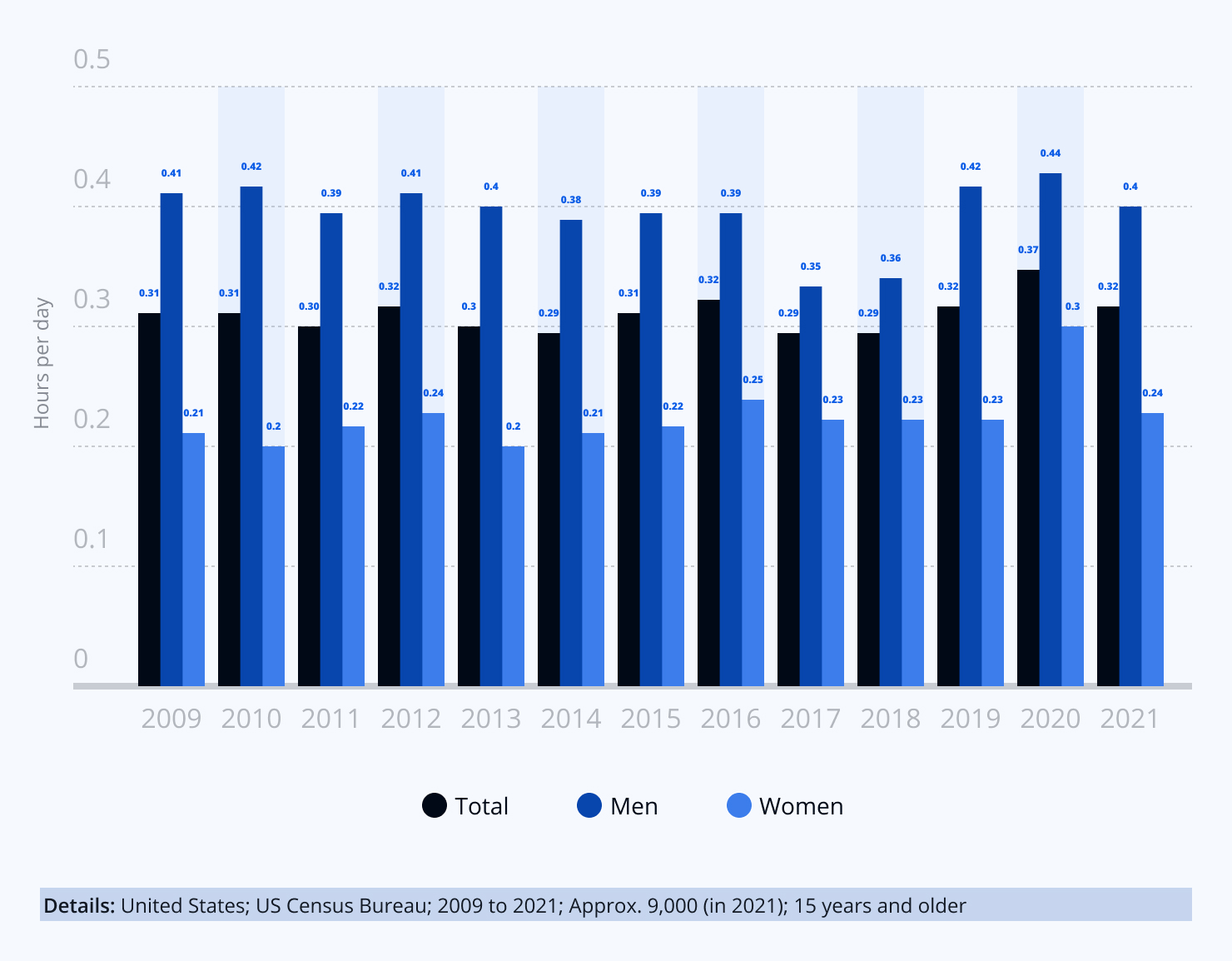
Americans’ daily commitment to sports, exercise, and recreation[7] activities offers an interesting glimpse into the country’s fitness culture.
- People in the United States spend an average of 0.32 hours each day engaging in physical activity.
- The average amount of time that people spent exercising in 2011 was 0.3 hours per day.
- From a gender perspective, men in the U.S. devoted more time to physical activities than women did. In 2021, the daily average for men was 0.4 hours, as compared to women, who spent an average of 0.24 hours each day.
The U.S. People Taking Part In Outdoor Sports
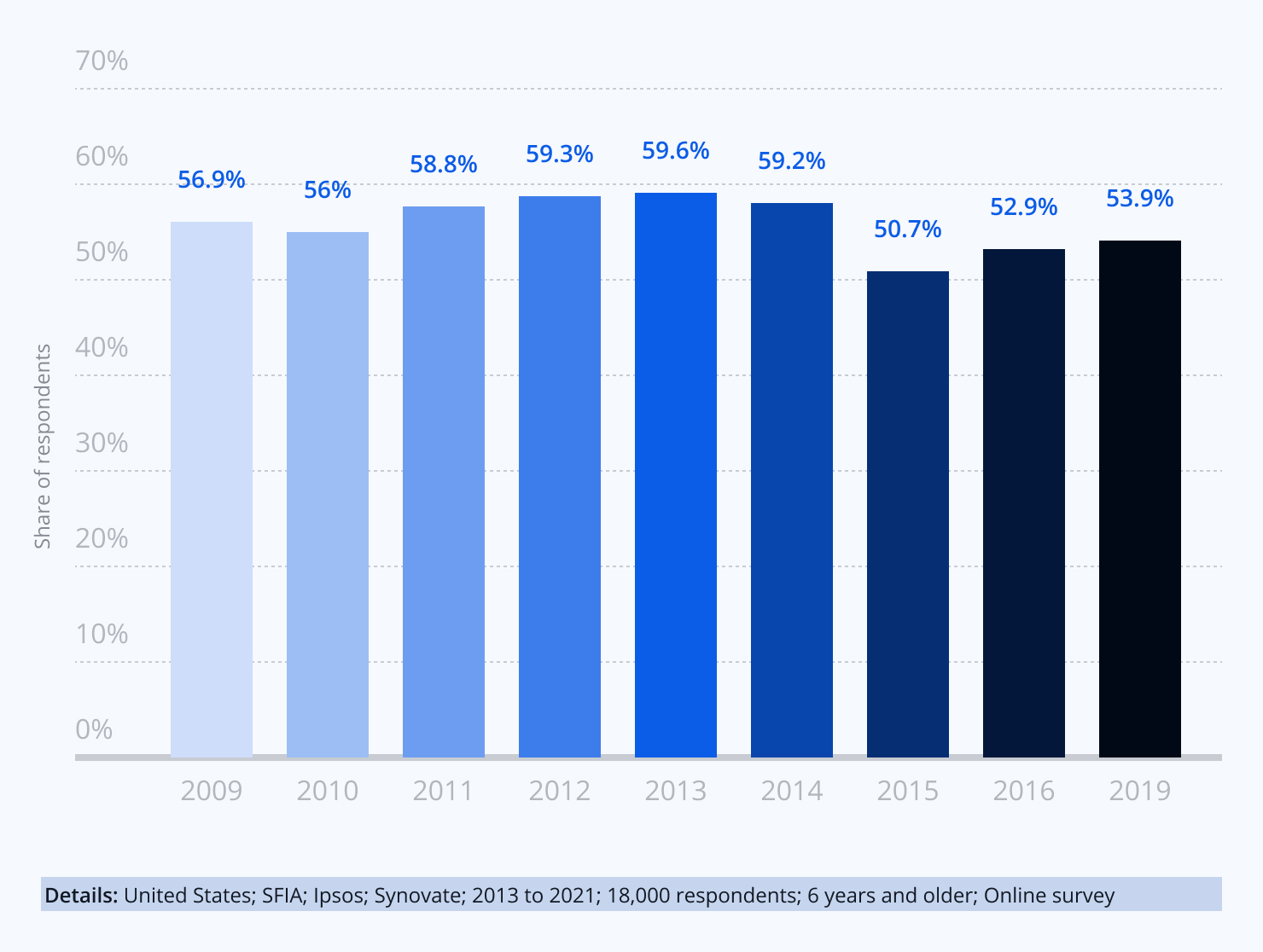
The number of U.S. people taking part in outdoor sports[8] has declined slightly since 2017. However, there’s been a gradual increase since 2020, perhaps as a response to the temporary pause on travel and activities due to the COVID-19 pandemic. In fact, a 2021 survey[9] found that Americans are spending 14 hours every week outside, an increase of three hours compared to the previous year. Additionally, 73% of respondents reported that spending time outside has been therapeutic.
- In 2013, 56.9% of Americans engaged in outdoor activities.
- In 2016, 59.3% participated in outdoor activities.
- The participation rate declined slightly and reached its lowest at 50.7% in 2019.
- Despite this downward trend, there was a slight rebound to 52.9% in 2020.
- This upward trend continued in 2021, with 53.9% of Americans engaging in outdoor sports.
Most Popular Gyms Among U.S. Consumers
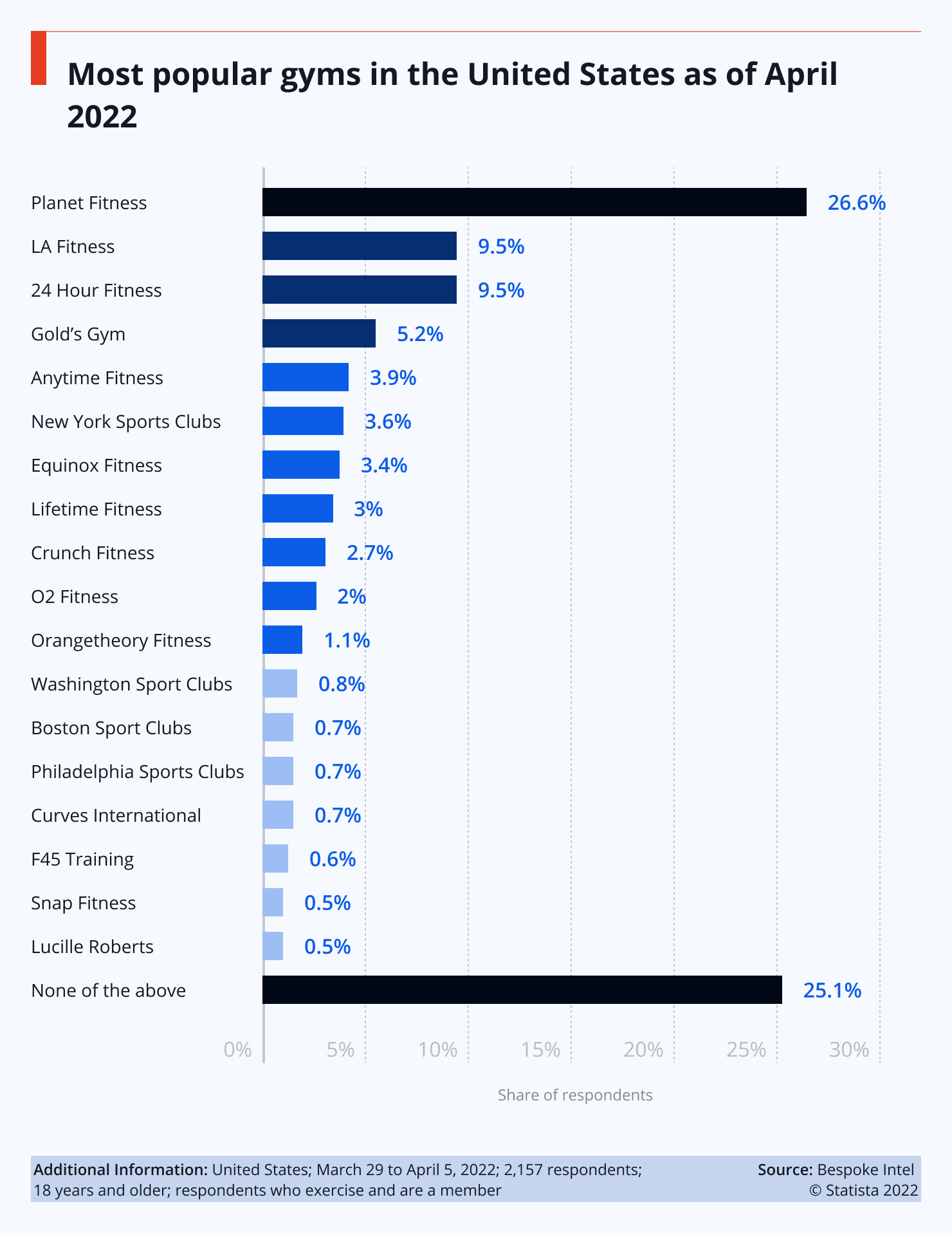
As interest in health and fitness continues to grow in the U.S., some gyms and clubs are also becoming increasingly popular.
- A survey[10] conducted in 2022 revealed that Planet Fitness was the most visited gym, chosen by nearly 27% of American consumers.
- LA Fitness and 24-Hour Fitness were not far behind in popularity, each accounting for 9.5% of surveyed gym-goers.
- 25% of respondents chose “none of the above” when asked which gym they frequented. This could imply that many people who are interested in health and exercise may opt for local or lesser-known gym brands, exercising at home, using health and fitness apps, or working out outdoors.
U.S. Fitness & Health Services Purchases In The U.S.
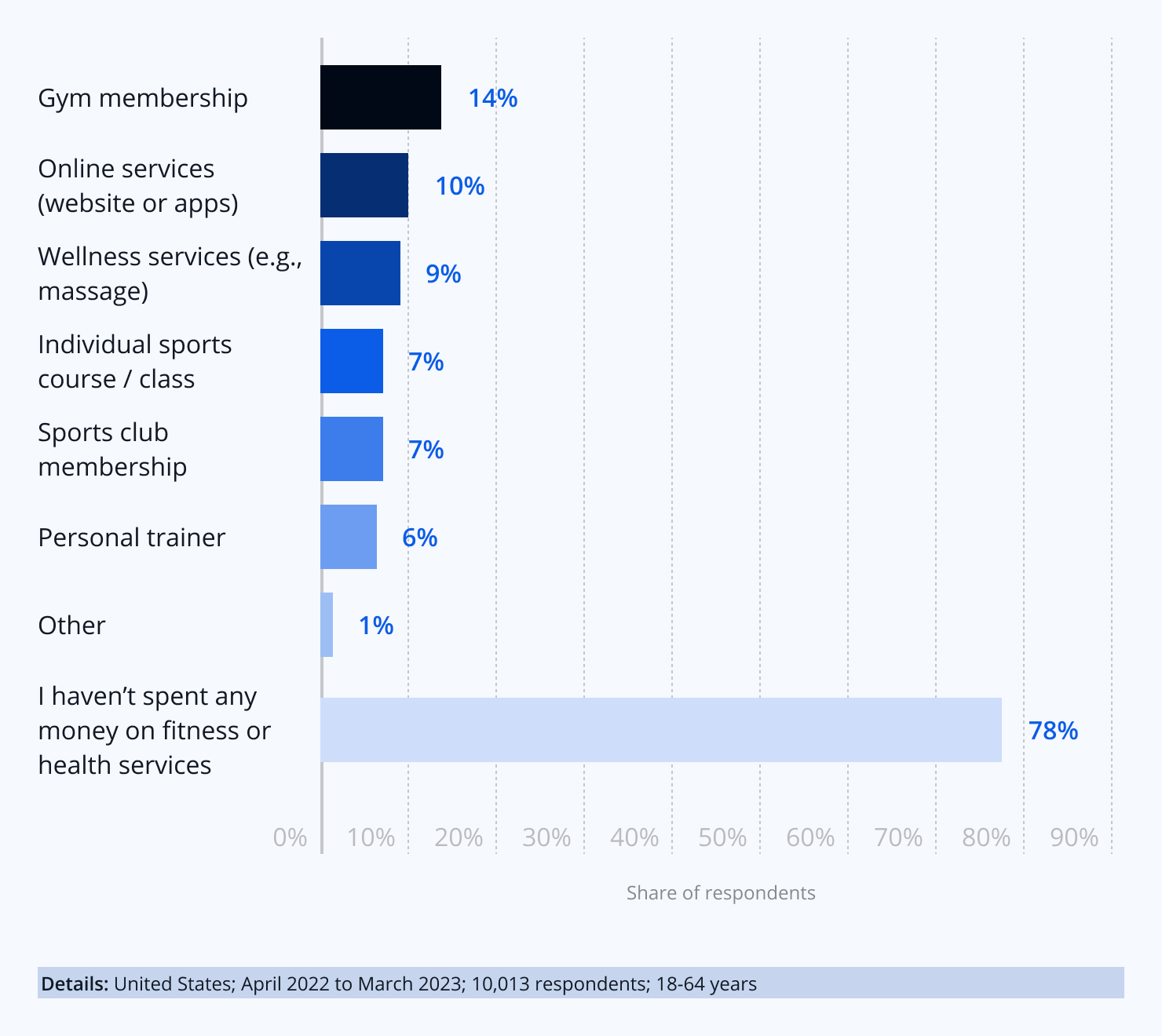
- As of 2023, 14% of U.S. respondents reported spending money on gym memberships[11]
- 10% opted for online services for exercise programs, such as websites and apps.
- On the other hand, a significant majority, nearly 80%, said that they hadn’t spent any money on fitness or health services.
Number Of Health Clubs By State
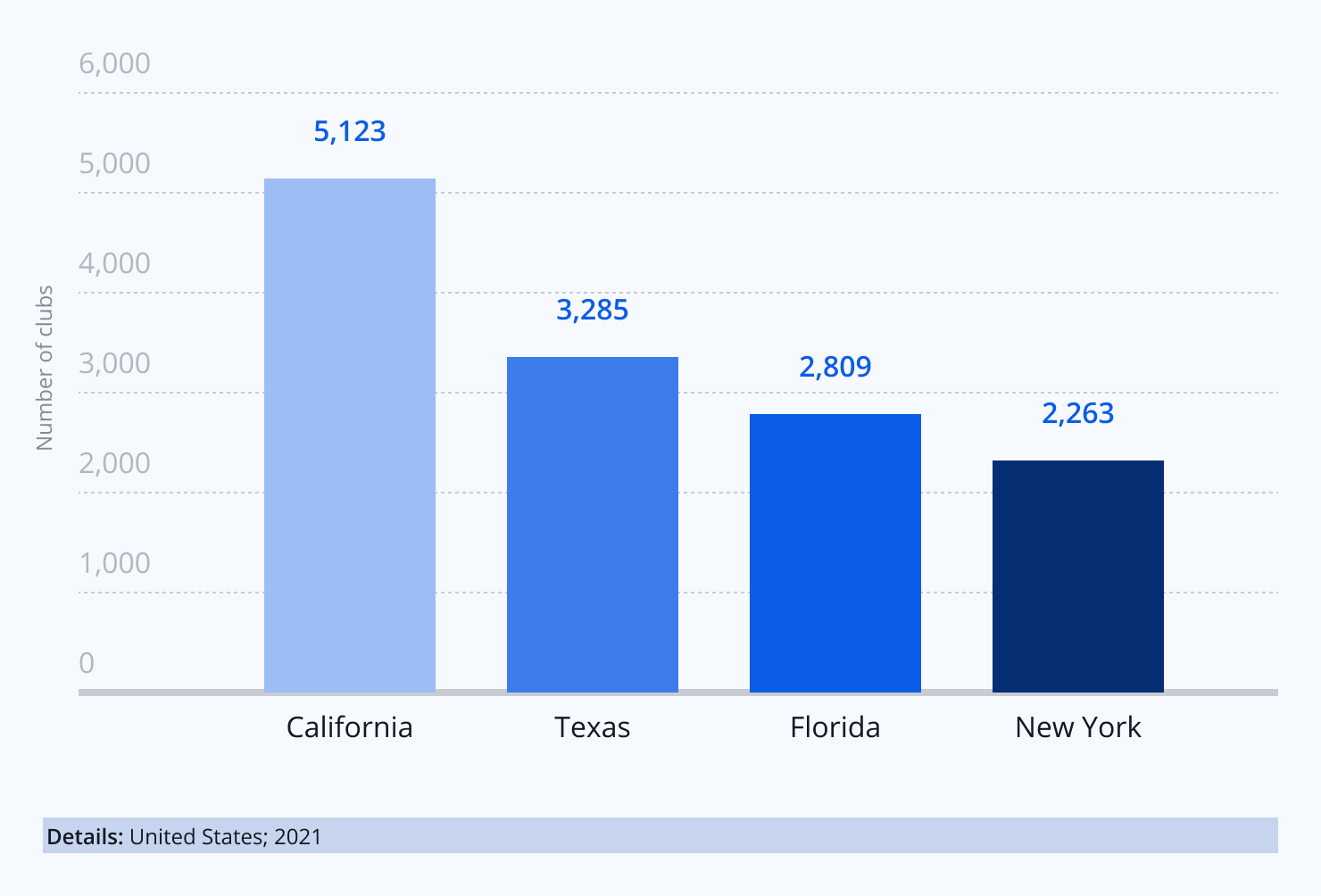
The distribution of health clubs across the United States[12] varies from state to state.
- California, the most populous state in the country, leads the nation in the number of health clubs, with over five thousand facilities.
- Texas, the second most populated state, has approximately 3,300 health clubs.
- On the East Coast, New York State has around 2,200 gyms.
- Florida has about 2,800 health clubs and gyms.
Leading Health Clubs
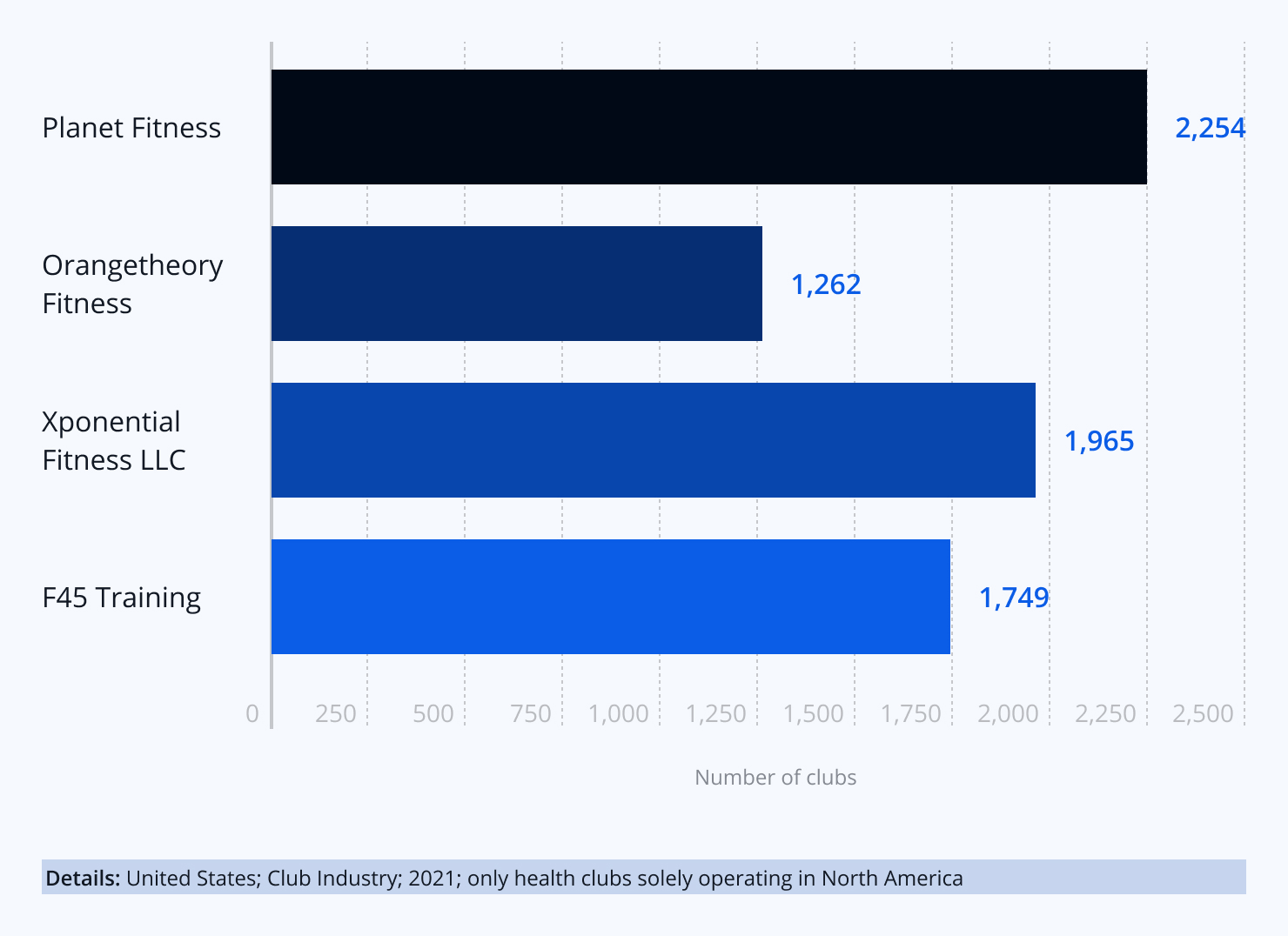
In terms of industry leaders[13], Planet Fitness led the health club industry with 2,254 fitness centers in 2021, followed by Orangetheory Fitness with 1,262 facilities. The dominance of these brands in the U.S. market may signal their successful strategies in capturing consumer interests through unique offerings and new technologies.
Average Monthly Cost Of Gym Membership
The average monthly cost of gym memberships[14] varies by state.
- In 2021, New York charged the highest rate at $75.32.
- In contrast, Wyoming offered a relatively affordable average monthly membership rate at $38.
These differences could be attributed to many factors, including real estate costs, the local economy of each place, as well as the amenities and incentives offered by the gyms in these areas.
Number Of Employees In The Gym, Health & Fitness Club Industry

The gym, health, and fitness club industry in the U.S. employed[15] over 887,000 people in 2022, representing a 37% increase from the 645,000 employed in 2012. Despite showing a slight dip from the previous year, the long-term trend illustrates the industry’s potential for job creation[16] and its crucial role in the U.S. economy.
Usage Reach Of Health & Fitness Apps
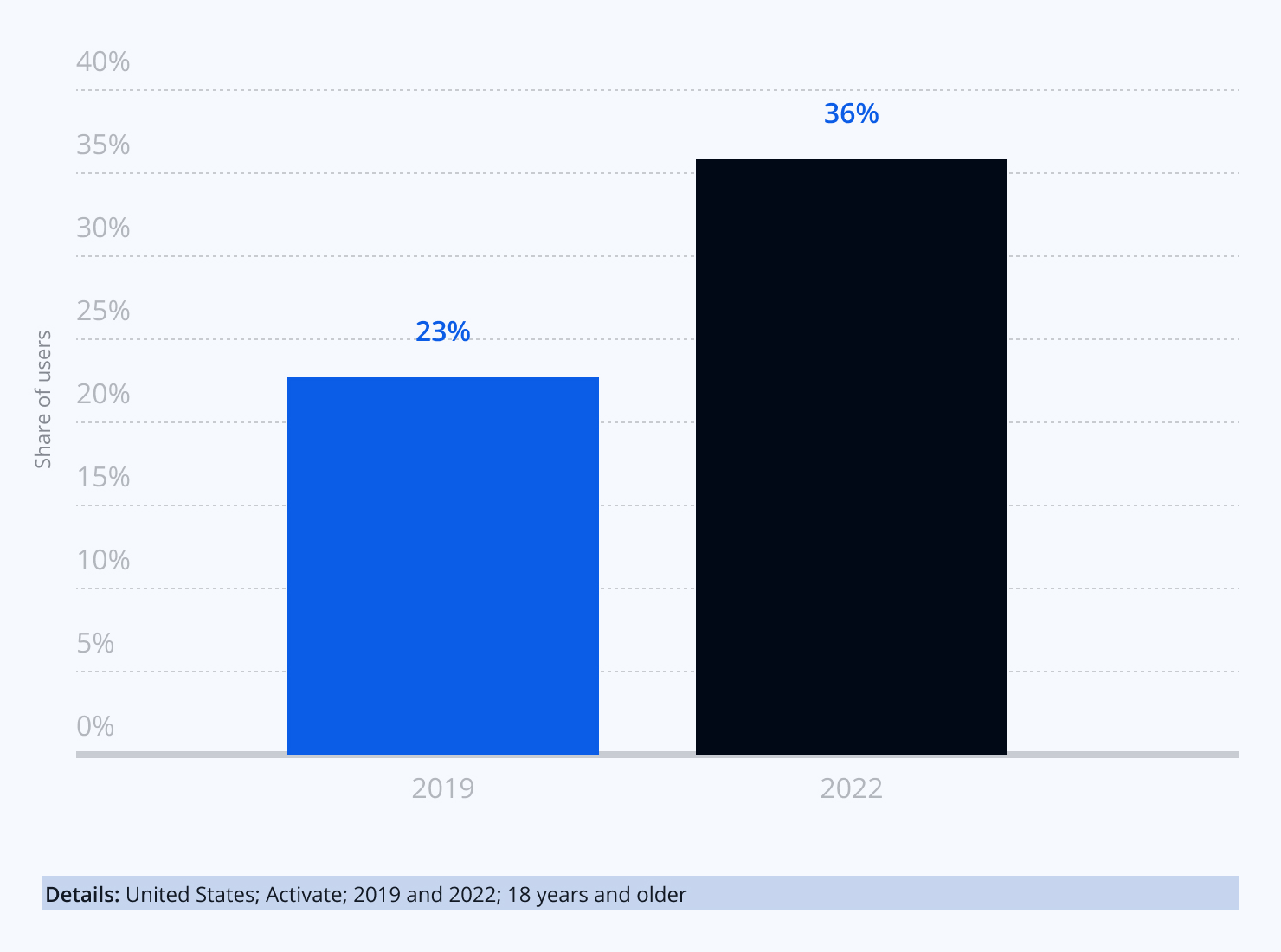
Health and fitness apps[17] have become increasingly popular in the United States in recent years.
- In 2019, health and fitness apps were used by 23% of consumers.
- By 2022, this number had grown to 36%.
This increased use may be due to the convenience these apps offer, as well as changes in exercise habits during the pandemic and beyond.
Leading Health & Fitness Apps By Downloads
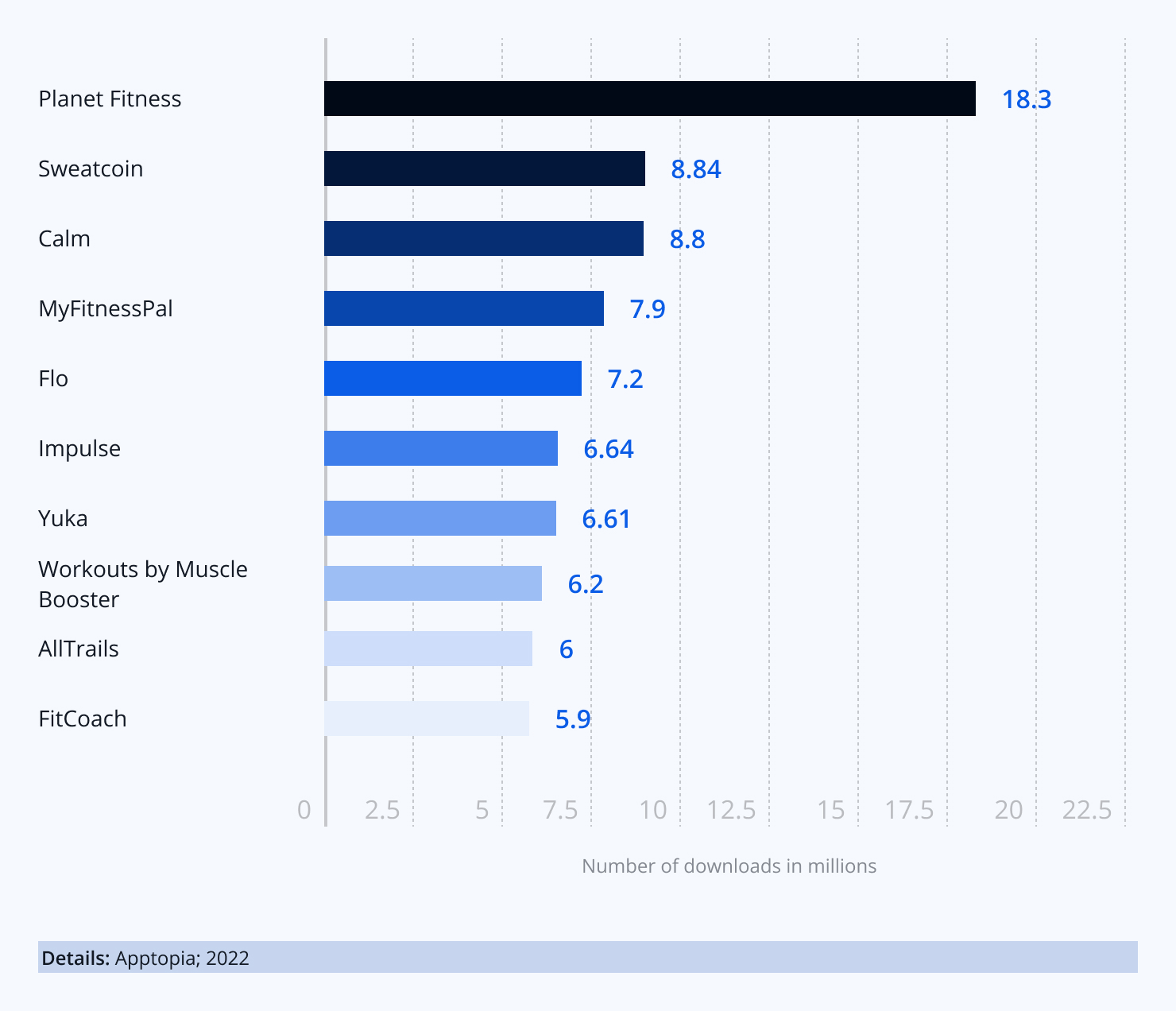
Digital trends[18] are shaping the U.S. fitness industry.
- Planet Fitness leads as the most popular health and fitness app of 2022.
- Other popular apps included Sweatcoin, a workout app; Calm, a meditation platform; and Flo, a women’s health and period tracking mobile app.
These apps signify the increasing integration of digital solutions into the health and fitness industry, catering to the demand for personalized and convenient wellness solutions.
Wearables & Connected Fitness Equipment Market Size
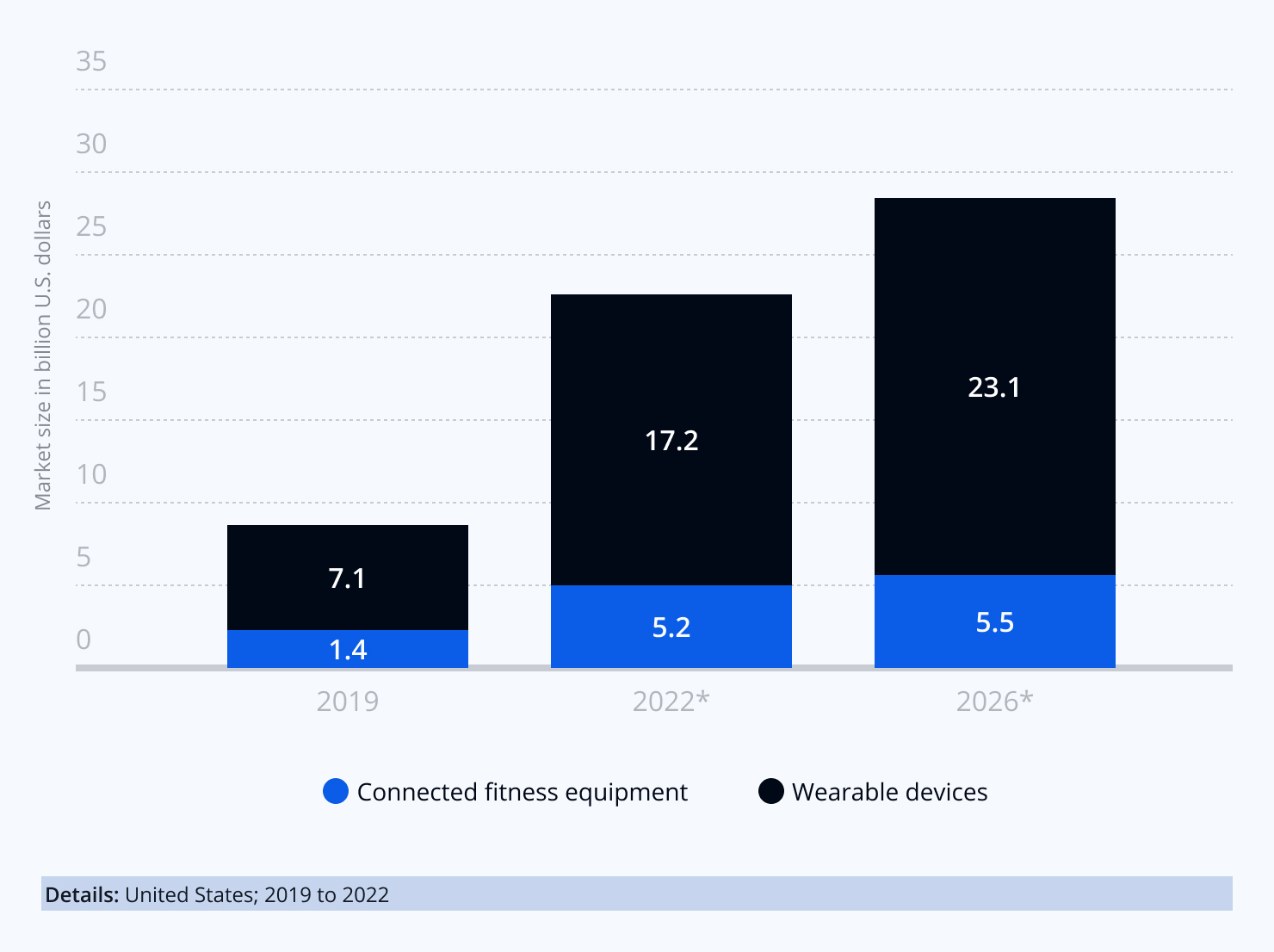
The U.S. market for wearable fitness technology[19] and connected fitness equipment has been growing quickly.
- In 2022, the wearables market size was valued at $17.2 billion, and predictions indicate that this figure will likely rise to over $23 billion by 2026.
- The connected fitness equipment market is set to experience a substantial increase of $300 million between 2022 and 2026.
Health Benefits Of Exercise
In the U.S., only one in five adults[20] meet the daily exercise recommendations. However, engaging in regular physical activity has numerous health benefits. These benefits range from improved physical health and fitness to enhanced mental health.
Health Benefits Of Physical Activity
Cardiovascular Health: Regular exercise, particularly moderate-intensity aerobic activity like walking, hiking, running, or cycling, strengthens the heart and improves overall cardiovascular health[21]. This can help lower the risk of heart disease and high blood pressure.
Muscle Strength and Bone Density: Strength or resistance training exercises target specific muscle groups, improving muscle mass, strength, and endurance and preventing loss of muscle mass with aging. If the sports target major muscle groups like calves (lower leg), hamstrings (back of the upper leg), quadriceps (front of the upper leg), and glutes (butt and hips), its effect would be bigger on the body’s fitness. Moreover, a 2020 research study[22] found that high-impact and odd-impact exercise, like running or playing soccer, may promote a higher bone density than no-impact sports such as swimming or leisurely cycling.
Body Composition: Regular physical activity paired with a healthy diet can help manage[23] body weight and reduce body fat.
Metabolic Health: Regular exercise can help regulate metabolic health[24], reducing the risk of developing metabolic syndrome, type 2 diabetes[25], and other related conditions.
Mental & Emotional Health Benefits
Improved Mood and Mental Health: Physical activity has been shown to trigger changes in the brain[26] that can make you feel happier, more relaxed, and less anxious. Plus, regular exercise can help reduce symptoms of depression[27] and anxiety disorders and lower the perception of pain.
Better Sleep: Physically active people can fall asleep faster, get better sleep, and wake up less during the night. Additionally, studies show[28] that physical activity can help regulate your body’s internal clock, known as the circadian rhythm, which, in turn, can reduce sleep disturbances and prevent or improve insomnia.
Enhanced Cognitive Function: Physical activity, especially aerobic exercise, has been shown[29] to have significant benefits for brain health and cognition, including improved concentration, attention, and learning.
Social Health Benefits
Exercising outdoors, joining a health club, or going to the gym also provides opportunities for social interactions and bonding[30], which can contribute to greater well-being and better mental health. Whether it’s a group fitness class, a personal training session, or a friendly match on the court, these activities offer a chance to connect with others who share similar fitness goals and lifestyles.
Conclusion
The global health and fitness industry has experienced robust growth, adapting to shifting consumer behaviors, demographic changes, technological advancements, and even a global pandemic. As the industry expands and innovates, it will continue to play an important role in the healthy lifestyle and well-being of people around the world.
In the U.S., the industry is marked by a push towards digital fitness solutions, an emphasis on mind and body wellness, and outdoor sports. The future of the industry promises exciting trends and developments, with numerous opportunities for businesses and consumers alike to benefit from a healthier and more active population.
However, the importance of these trends extends beyond the health and fitness industry itself. Regular physical activity, whether it is through gyms, health clubs, digital fitness solutions, or outdoor activities, plays a vital role in enhancing overall health and well-being. It reduces the risk of many chronic diseases, boosts mental health, and improves the quality of life.
Author Information
Diana Zambrano
Health & Wellness Copywriter
Media Contact
Erik Pham
Founder of Health Canal
[email protected]